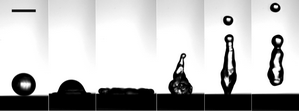Crossref Citations
This article has been cited by the following publications. This list is generated based on data provided by
Crossref.
Khan, Sami
Azimi, Gisele
Yildiz, Bilge
and
Varanasi, Kripa K.
2015.
Role of surface oxygen-to-metal ratio on the wettability of rare-earth oxides.
Applied Physics Letters,
Vol. 106,
Issue. 6,
Cho, H. Jeremy
Preston, Daniel J.
Zhu, Yangying
and
Wang, Evelyn N.
2016.
Nanoengineered materials for liquid–vapour phase-change heat transfer.
Nature Reviews Materials,
Vol. 2,
Issue. 2,
Yilbas, Bekir Sami
Yousaf, M. Rizwan
Ali, H.
and
Al‐Aqeeli, N.
2016.
Replication of laser‐textured alumina surfaces by polydimethylsiloxane: Improvement of surface hydrophobicity.
Journal of Applied Polymer Science,
Vol. 133,
Issue. 41,
Awin, Eranezhuth Wasan
Sridar, Soumya
Shabadi, Rajashekhar
and
Kumar, Ravi
2016.
Structural, functional and mechanical properties of spark plasma sintered gadolinia (Gd 2 O 3 ).
Ceramics International,
Vol. 42,
Issue. 1,
p.
1384.
2017.
Bioinspired Superhydrophobic Surfaces.
p.
111.
Matovic, Branko
Maletaskic, Jelena
Djordjevic, Marija Prekajski
Maksimovic, Vesna
Zagorac, Jelena
Yoshida, Katsumi
and
Yano, Toyohiko
2017.
Synthesis and characterization of nanometric gadolinia powders by room temperature solid-state displacement reaction and low temperature calcination.
Journal of the European Ceramic Society,
Vol. 37,
Issue. 8,
p.
2843.
TANIMOTO, Remi
YOSHIKAWA, Koichiro
ISOBE, Toshihiro
MATSUSHITA, Sachiko
and
NAKAJIMA, Akira
2017.
Effects of storage atmosphere and surface roughness on the hydrophobicity of Gd<sub>2</sub>O<sub>3</sub> thin film and sintered body.
Journal of the Ceramic Society of Japan,
Vol. 125,
Issue. 8,
p.
638.
Sharifi, Navid
Ben Ettouil, Fadhel
Moreau, Christian
Dolatabadi, Ali
and
Pugh, Martin
2017.
Engineering surface texture and hierarchical morphology of suspension plasma sprayed TiO 2 coatings to control wetting behavior and superhydrophobic properties.
Surface and Coatings Technology,
Vol. 329,
Issue. ,
p.
139.
Wei, Xue-Ling
Li, Na
Yi, Wen Jun
Li, Li-Jun
and
Chao, Zi-Sheng
2017.
High performance super-hydrophobic ZrO2-SiO2 porous ceramics coating with flower-like CeO2 micro/nano-structure.
Surface and Coatings Technology,
Vol. 325,
Issue. ,
p.
565.
Xu, Pengyun
Coyle, Thomas W.
Pershin, Larry
and
Mostaghimi, Javad
2018.
Superhydrophobic ceramic coating: Fabrication by solution precursor plasma spray and investigation of wetting behavior.
Journal of Colloid and Interface Science,
Vol. 523,
Issue. ,
p.
35.
Prakash, Saurav
Ghosh, Siddhartha
Patra, Abhijeet
Annamalai, Meenakshi
Motapothula, Mallikarjuna Rao
Sarkar, Soumya
Tan, Sherman J. R.
Zhunan, Jia
Loh, Kian Ping
and
Venkatesan, T.
2018.
Intrinsic hydrophilic nature of epitaxial thin-film of rare-earth oxide grown by pulsed laser deposition.
Nanoscale,
Vol. 10,
Issue. 7,
p.
3356.
Shim, Jaehwan
Seo, Donghyun
Oh, Seungtae
Lee, Jinki
and
Nam, Youngsuk
2018.
Condensation Heat-Transfer Performance of Thermally Stable Superhydrophobic Cerium-Oxide Surfaces.
ACS Applied Materials & Interfaces,
Vol. 10,
Issue. 37,
p.
31765.
Yilbas, Bekir S.
Ali, Haider
Yousaf, Muhammad R.
and
Al-Sharafi, Abdullah
2018.
Comprehensive Energy Systems.
p.
796.
Bai, M.
Kazi, H.
Zhang, X.
Liu, J.
and
Hussain, T.
2018.
Robust Hydrophobic Surfaces from Suspension HVOF Thermal Sprayed Rare-Earth Oxide Ceramics Coatings.
Scientific Reports,
Vol. 8,
Issue. 1,
Annamalai, Meenakshi
Prakash, Saurav
Ghosh, Siddhartha
Patra, Abhijeet
and
Venkatesan, T.
2019.
Advances in Contact Angle, Wettability and Adhesion.
p.
17.
Khan, Shoukat Alim
Tahir, Furqan
Baloch, Ahmer Ali Bozdar
and
Koc, Muammer
2019.
Review of Micro–Nanoscale Surface Coatings Application for Sustaining Dropwise Condensation.
Coatings,
Vol. 9,
Issue. 2,
p.
117.
Matsumoto, Takumi
Sunada, Kayano
Nagai, Takeshi
Isobe, Toshihiro
Matsushita, Sachiko
Ishiguro, Hitoshi
and
Nakajima, Akira
2019.
Preparation of hydrophobic La2Mo2O9 ceramics with antibacterial and antiviral properties.
Journal of Hazardous Materials,
Vol. 378,
Issue. ,
p.
120610.
Yasmeen, Sumaira
Khan, Mohammad Rizwan
Park, Kiho
Cho, Yunshik
Choi, Jang Wook
Moon, Hyoung-Seok
and
Lee, Han-Bo-Ram
2020.
Preparation of a hydrophobic cerium oxide nanoparticle coating with polymer binder via a facile solution route.
Ceramics International,
Vol. 46,
Issue. 8,
p.
12209.
Shao, Xiao-yan
Zhu, Li-na
Yue, Wen
Kang, Jia-jie
Ma, Guo-zheng
Fu, Zhi-qiang
She, Ding-shun
Wang, Hai-dou
Feng, Mei-gui
and
Wang, Cheng-biao
2020.
Hydrophobicity and wear resistance of ceria/PTFE composite coatings.
Journal of Coatings Technology and Research,
Vol. 17,
Issue. 6,
p.
1549.
Xu, Pengyun
Coyle, Thomas W.
Pershin, Larry
and
Mostaghimi, Javad
2020.
From lotus effect to petal effect: Tuning the water adhesion of non-wetting rare earth oxide coatings.
Journal of the European Ceramic Society,
Vol. 40,
Issue. 4,
p.
1692.
